Saturday, October 31, 2009
Top 5 Future Cell Phones
Friday, October 30, 2009
Thursday, October 29, 2009
Planning Sustainable Communities: “It’s More than Being Green”

4 posts in 24 hours : 22 posts in 4 weeks
All Aboard! Clever Recycled Train Car Homes, Offices & Hotels
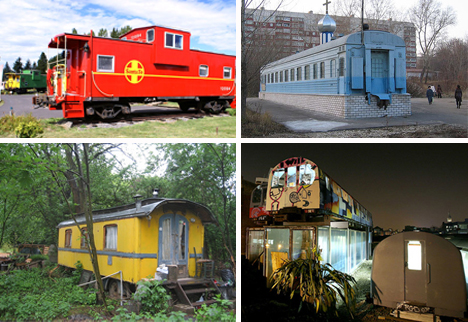
Railroad cars are big, heavy, and cumbersome. They’re notoriously hard to move into new locations off of their tracks, and because of their odd shape most people wouldn’t think of using them for anything else anyway. But in the spirit of recycling, green construction and shipping container homes, some enterprising people are recycling old train cars into homes, offices and even hotels.
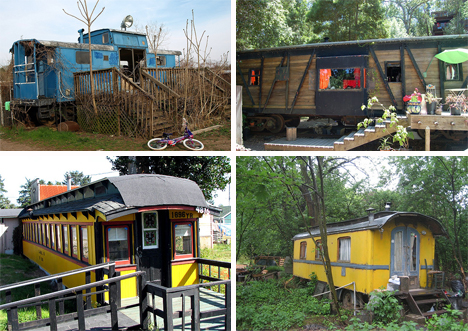
(images via: Jag9889, The Manimal, The Greenest Dollar, and Ramon)
With the mortgage industry in trouble and more people making the shift toward green housing, reusing train cars as homes is a logical step. Like shipping containers, it’s relatively easy to do the conversion yourself, provided you have the resources to get the car to its new location. Cabooses seem to be the most popular choice for train car homes, but there are plenty of dining and sleeping cars being converted as well. If you’re able to shell out between $8000 and $45,000 for an old car, another several thousand to transport the car and put it into place on your property, and whatever it takes in material and labor to transform it, you can have a home for much less than a conventional house would cost. And best of all, it will be completely unique and as green as you want it to be.
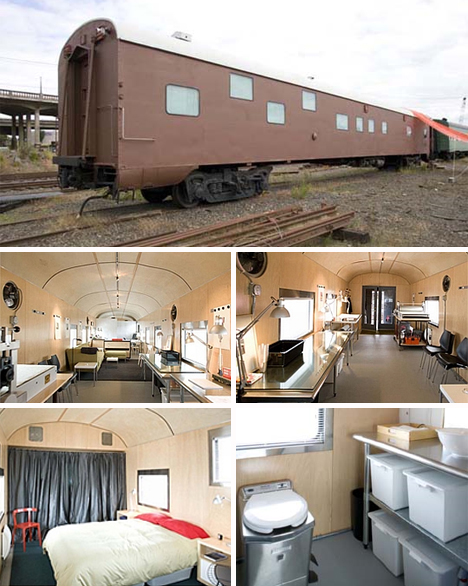
(images via: kgw.com)
This converted rail car home in Portland, Oregon, is a great example of how beautiful a home a converted railroad car can make. The outside may look plain, but on the inside it’s surprisingly luxurious. The home encompasses an impressive 807 square feet and features 10-foot-high ceilings, DSL, thoroughly new everything, a full electric kitchen, and an incinerator toilet. The siding it’s currently situation on is rented to the current owner for $150 a month, and since it’s not technically real estate there are no property taxes. The home is currently for sale, so if you want the train car home experience without renovating one yourself, now’s your chance.
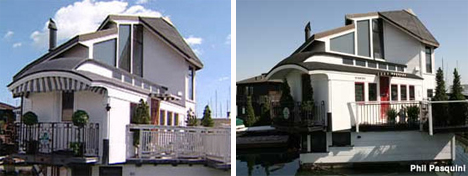
(images via: HGTV and Roadside America)
If you’ve ever passed by the northern edge of Richardson Bay in Sausalito, California, chances are you’ve seen some pretty unusual houseboats moored there. One of the most unique is this one, made from an old railroad car. The car was once known as #41 on the San Francisco and Northern Pacific Railway in 1889. After it was retired in 1936, it was made into a land-based duplex and stayed put until 1979. At that time it was purchased to be made into this amazing houseboat. The home contains many of the original rail car bits, including the dining seats and some of the interior wood.
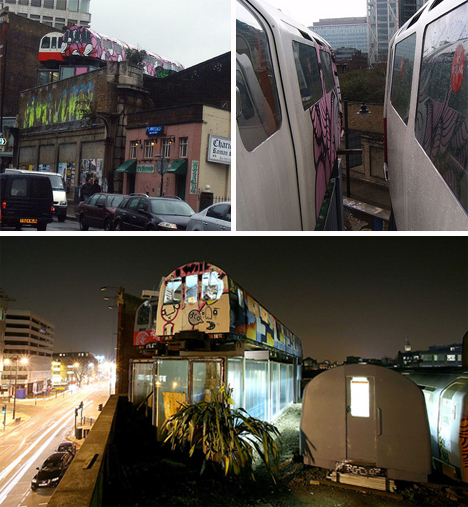
(images via: London Underground and Village Underground)
High above the London streets in Shoreditch, a few disused Tube carriages sit proudly, adorned with beautiful graffiti and shining with new life. They’re part of Village Underground, a collection of office and studio spaces that encompass the carriages above as well as a massive Victorian warehouse below. A wide variety of occupants take up the spaces, making a truly diverse and unique urban community encompassing some very distinctive recycled building elements.

(image via: Anne Vauclare)
Not all repurposed train cars are used as dwellings or offices. Sometimes, it’s simply a matter of using the available material to solve the problem at hand. Though it’s not clear exactly where this train car bridge is or even how it got there – miles away from a highway or railroad network – it’s an amusing sight.
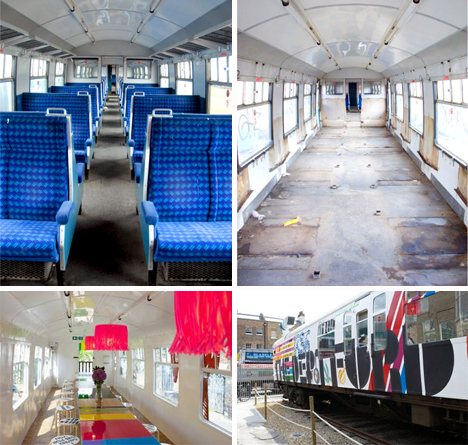
(images via: The Deptford Project)
In mid-2008, a remarkable project came together in Deptford, South London: a 1960s rail car was transported to the high street to become part of an urban reclamation arts project. The car was stripped and repurposed by designer Morag Myerscough, then turned into a café. The Deptford Project Café is now decorated with beautiful graffiti advertising its existence, and inside you can get a cup of sustainably-harvested coffee or a plate of locally produced treats.
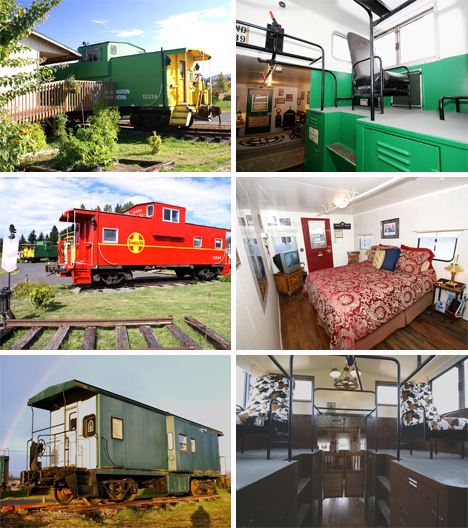
(images via: Redcaboose Getaway B&B)
Some enterprising individuals put the homey feel of converted rail cars to good use as bed and breakfast rooms. The Redcaboose Getaway on Washington’s Olympic Peninsula manages to look both charming and exciting. If you ever wanted to be a train conductor as a kid, this is the place to live out that dream…sort of. The B&B features several cabooses, each of which is a separate guest chamber. There’s also a restored art deco dining car where the staff chef prepares breakfast each morning. The Olympic Peninsula is one of the must-see areas of the US, and this seems like an amazing place to call a temporary home while exploring the area.
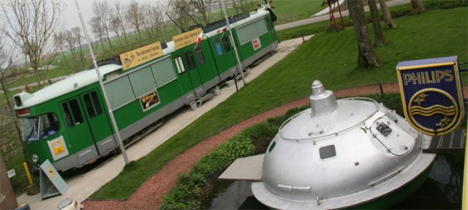
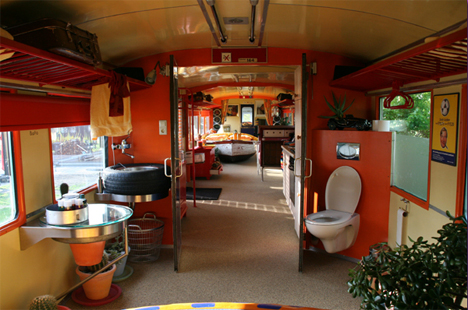
(images via: Controversy B&B)
The Controversy B&B in Hoogwoud, Netherlands takes full advantage of the offbeat nature of the discarded train on its grounds. The compartment is 21 meters long and contains some truly wacky features: the sink basin in the bathroom is an old tire, the bed is a boat, and the jacuzzi tub is in the shape of a colorful sombrero. And if trains aren’t your thing, the transportation-themed property also features trams and a UFO.
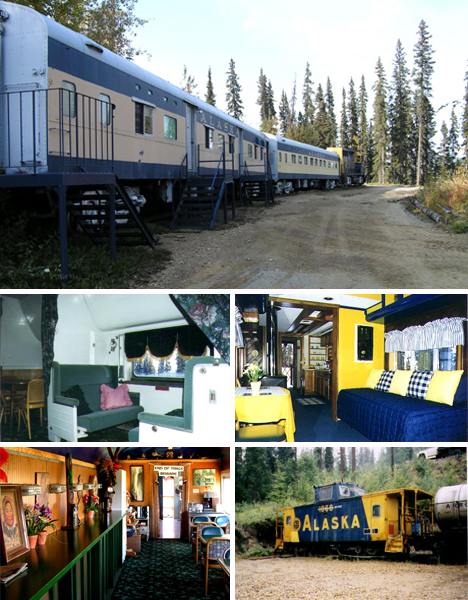
(images via: Aurora Express B&B)
Fairbanks, Alaska boasts its own quirky railroad car bed and breakfast. The Aurora Express B&B features four historic railroad cars as sleeping chambers and one dining car. The cars were purchased from the Denali State Park Hotel for $1 each, with the agreement that the Wilson family would pay to transport them to their property. Today, the cars sit on 700 feet of private railroad track overlooking Fairbanks and the Tanana Valley.
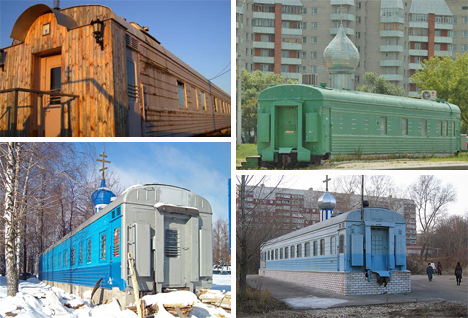
(images via: English Russia)
Perhaps the most bizarre train reuse is the Russian trend of converting old train cars into Orthodox Christian churches. They range from the simple repurposing to the elaborate redesign, complete with adding an entirely new facade. The end result is an unusual but inspirational presentation, showing us that these industrial giants don’t need to be discarded when their working lives are over; they simply need someone who cares enough to give them new life.
Cargo & Shipping Container Home & Office Designs
Cargo containers are of increasing interest to architects who plan to make them into homes, offices and other buildings through simple modifications and conversions.
2 Comments - Click Here to Read More »»
A New Form of Vehicle Intelligence
More here: Winking robot nav head knows where you’re going
“MIT intends to revolutionize GPS navigation by making it friendly and predictive, using a friendly robot helper to anticipate your needs. The Affective Intelligent Driving Agent (AIDA) is a robot head on an articulated neck, reminiscent of movie robots from the 1980s, that mounts in the center of the dashboard.
It incorporates an expressive “face” that can smile, look sad, show warning signs, and even wink at you. AIDA was developed as a collaboration between the Personal Robots Group at the MIT Media Lab, MIT’s SENSEable City Lab, and Volkswagen Group of America’s Electronics Research Lab…”
Of course, this is simply a “cool” way to introduce systems. The reality is, there won’t be any smiling robots (unless you want a ticket for distracted driving or “winking back at your controller.”) The technology behind it will most likely not be in easy view.
Then, all of a sudden, something similar to this happens to you:
Times Square BID Leader on the Art of Street Reclamation
 This used to be the scene of gridlocked traffic. Photo: berk2804
This used to be the scene of gridlocked traffic. Photo: berk2804Seven years ago, when Tim Tompkins took over as president of the Times Square Alliance, one of New York's largest BIDs, security and cleanliness were the top concerns. Despite incessant traffic and "pedlock," few decision-makers were focused, at first, on the vision of Times Square as a world-class public space where people take precedence over motor vehicles.
Speaking to a standing-room audience at the San Francisco Planning and Urban Research building last week, Tompkins recalled when the lack of regular stabbings and violent crime seemed good enough for the crossroads of the world, and the quality of public space felt too esoteric to address. Gradually, Tompkins helped build public support for dramatic changes, starting with the re-design of Duffy Square. Working with NYCDOT, Tompkins began chipping away at the space allocated to cars and opening it up to pedestrians. Shortly after the completion of Duffy Square last October, said Tompkins, DOT Commissioner Janette Sadik-Khan approached him about closing down a portion of Broadway to vehicles to create public plazas.
Now, cities around the country view the new Times Square plazas as potential precedents for transforming their own under-utilized or overcrowded streets into quality pedestrian space. Streetsblog San Francisco caught up with Tompkins during his west coast trip to talk about the new Times Square, how it came about, and the lessons we can draw from its ongoing transformation. Here is an edited transcript of the interview.
Matthew Roth: What in your opinion has been the biggest change in Times Square over the past decade?
Tim Tompkins: The challenge of Times Square as a public space had changed. It’s not enough that it's just sort of safe to be there. This is one of the world's great public spaces. What's missing?
Over the last couple of decades we've learned a lot about how to make parks great, and that parks are important to life of the city. I think there's been an evolution over the last decade thanks to organizations like [Streetsblog], and Project for Public Spaces, and Transportation Alternatives that have said, "There is another part of the public realm, there is another part of city life that we need to pay attention to."
What I see is that what’s been happening is part of a larger movement in terms of the revitalization of cities. It’s kind of Maslow’s hierarchy of needs, where you need to take care of the basics of comfort and security first before you can even think about anything else. That played out with respect to nature and parks, but wasn't really playing out in the streets and sidewalks. I think not only in Times Square and in New York City, but in a bunch of places... we've been paying attention to that. And that’s been the paradigm shift that’s driving a lot of this.
 The re-designed Duffy Square. Photo: Brad Aaron.
The re-designed Duffy Square. Photo: Brad Aaron.This is a place where you can be still, but you're still in the city. You're experiencing the city, but you don't have to stand or walk through it the way you did before. Finally, we created a place for that observation to happen, for people to see what we called the second best show on Broadway, which is Times Square itself. It’s people watching people in this unique way. And so sometimes it’s about looking up, sometimes it’s about noticing the store across the street, but as much as anything it’s about watching this urban fugue, which is the special nature of a public space in the city, where you’ve got all these different things going on. Different people, different languages, different looks, and a little bit of chaos, but also a tremendous amount of energy.
MR: Now that you've closed portions of Broadway to cars and opened it up to people, what would you say to skeptics of pedestrianization and pilots that limit private vehicles?
TT: Pedestrianization of a former roadway is a mixture of art and science. There are people who have studied this -- you know, what do people do in public spaces -- and sometimes it works, sometimes it doesn’t. It has to do with design, management, the nature of the space, what’s going on around it. So it’s not an easy thing to get right. One of the great things about this commissioner and mayor is that they’re willing to experiment and see what happens.
We're still learning how to make this work. How to bring some authentic sort of street-style programming back to Times Square without overwhelming it, without it being too noisy for the office tenants, or the theaters. How to have the furniture look good, but not be just like everything else. Even just how you keep it clean so it doesn’t look ratty. Because when it was asphalt it’s like, "Well this is a street, it’s not supposed to look good." The second it was painted red asphalt, then there was this challenge, because people were no longer looking at it as a street that happened to have a chair on it, they were looking at it as a public space, and they were like, "This is not Piazza San Marco, this is crap." And in some ways they're right, but it's a function of shifting expectations.
MR: What has the reaction been among businesses in the district?
TT: I think that there was definitely concern and fear during a time of economic vulnerability, and you've got to acknowledge that. Longer-term interests, like somebody that owns an office building, they’re there for decades, but you know, restaurants in Times Square live hand to mouth. If Broadway tickets are down 20 percent, their business is down 20 percent. You have to pay attention to the reality of somebody's economic situation.
"The second it was painted red asphalt, then there was this challenge, because people were no longer looking at it as a street that happened to have a chair on it, they were looking at it as a public space, and they were like, 'This is not Piazza San Marco, this is crap.'"
I think at the same time listen to what they say, and then modify the plan accordingly. There were some issues about theater access on 45th Street, and what was going to happen when you change the traffic patterns. We had conversations and DOT was great. They sat down and they said, "Okay, we were initially thinking we wouldn’t let you make a right turn, but we’re going to modify the plan and allow that to happen," and that addressed a really big issue. So that’s another case where it's important to have the conversation between the private interests and the government that’s doing it. And to say, you know, maybe that might not have worked, and then we would have had to say, "Okay, we're three weeks into it, let’s change something else."
The other thing to keep in mind, though, is that you've got to think about your long-term competitiveness. A business understands that you've got a competitive environment. What are your advantages versus some other place? In a place like San Francisco, in a place like Times Square, they're major tourist destinations, and people can choose to go somewhere else. Just like whether it's an amusement park, or it's a beach resort, they’ve got to do some upgrades, they've got to pay attention to the competitive environment and say, "What’s going to keep people coming here?"
Photoshop Dersleri İçin 38 Harika Web Sitesi
Photoshop, tasarımcılar için sadece bir meslek değildir. Aynı zamanda alışkanlık ve bağımlılık yaratır. Herhangi bir sınırı yoktur. Yeni başlayanlar kolayca öğrenebilir. Dersler, photoshop öğrenmek için en iyi çözümlerden birisidir. Deneyimli kullanıcıların yayınladığı bu dersler ile yeni başlayanlar ve uzman kişilere çok yararlı olacaktır. Photoshop öğrenmek için aşağıda harika ders siteleri yer almaktadır.



ilgili yazılar
- Hiçbir Zaman Ölmeyecek 28 Photoshop Dersi (11)
- Size Sıfırdan Photoshop Öğretecek 35 Kaynak (10)
- 28 inanılmaz photoshop dersi (poster yapımı, me... (10)
- 24 Hayran Eden Photoshop Dersi (4)
- 50 büyüleyici photoshop dersi (3)
- 15 Photoshop ürün reklamı tasarımı dersi (1)
- Kendi Galaksini Yarat [photoshop dersleri] (9)
- 45 Photoshop Ders Sitesi (6)
- Photoshop Bilmeyenlere özel, 7 Adet Fotoğraf İş... (20)
- 10 adet ücretsiz Photoshop 3d metin efekti dersi (11)
bu yazı LeBron tarafından bildirgec.org adresli sitede yayımlanmak üzere yazılmıştır. kaynak gösterilmeksizin kopyalanamaz.
etiketler: photoshop, dersler, photoshop dersleri, photoshop tutorials, tasarımcılar, photoshop tutorial, photoshop öğrenmek, photoshop dersi, photoshop ders siteleri, photoshop öğrenmek istiyorum, ders siteler
Tasarımcılar için 760+ photoshop dersi
İnternette istemediğimiz kadar photoshop dersi var ama o kadar dağınık ki hangi ders hangi sitede bulması ve takip etmesi oldukça zor. Bu noktada işimize çok yarayacak bir derleme ile karşılaşınca burada paylaşmak istedim.
manipülasyondan illüstrasyona, yazı efektlerinden fırça kullanımına, web site tasarımından menü tasarımına kadar tam 760 photoshop dersinin bir araya toplandığı, her web&grafik tasarımcısının kesinlikle elinin altında olması gereken bir kaynak.
30 Retro tarzında photoshop dersi
Oldschool ve Retro tarzında tasarım yapmak isteyenler için 30 photoshop dersi.

Hayal gücünüzün ötesinde 50 fantastik manipülasyon dersi
Specky Boy Design Magazine'den hayal gücünün sınırlarını zorlayan 50 adet fantastik foto manipülasyon dersi

Web siteleriniz için 18 Header tasarımı dersi
Web sitelerinize profesyonel görünüm kazandırmak için işinize yarayacak 18 header tasarımı.

ilgili yazılar
- 50 Gerçekten Yüksek Kaliteli Photoshop Navigasy... (4)
- 101 Adet CSS Kaynağı (10)
- mtv yeni tasarımı ve illüstrasyonları (6)
- kasırga afiş projesi (0)
- 27 Photoshop Web Site Tasarımı Dersi (8)
- 15 Photoshop ürün reklamı tasarımı dersi (1)
- Yeni Başlayanlar İçin Hızlı Illustrator Kursu (0)
- 50 adet şık illüstrasyon dersi (4)
- katalog tasarim, katalog hazırlama, katalog yar... (0)
- 40 Gerçekten Kullanışlı Photoshop Metin Efekti ... (7)
bu yazı siriusbee tarafından bildirgec.org adresli sitede yayımlanmak üzere yazılmıştır. kaynak gösterilmeksizin kopyalanamaz.
etiketler: tasarım, illüstrasyon, afiş, menü, grafik tasarım, buton, template, web sitesi, manipülasyon, photoshop dersleri, logo tasarım, web site tasarımı, photoshop dersi





